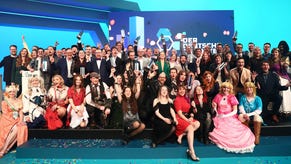Facial animation research
University of Abertay student studies emotional expressions.
For immediate release: Wednesday 28 July
A University of Abertay Dundee researcher believes his studies into facial expressions could shape the future of animation by making film and computer game characters more credible.
Robin Sloan, PhD student and lecturer based in the Institute of Arts, Media and Computer Games, has devised a set of rules to help animators sequence their facial animations to portray a more convincing emotion.
Robin’s study involved investigating the effectiveness of choreographed emotional expressions. To do this, he ran a series of experiments studying how the upper and lower regions of the face move during expressions of, say, happiness, surprise or anger.
The long-term aim was to make every stage of the choreography as believable as possible. He also used human actors and willing participants in order to study realistic expressions, inducing genuine emotions in the latter by making them watch a film scene that was, for example, funny or disgusting.
Robin, who initially studied Computer Arts at Abertay University, found that, for sadness to look authentic, it needs to lead from the upper face – essentially, the furrowing of the brow and lowering of the eyes should occur before the mouth corners turn downward.
If this expression unfolds the other way round, it can look childlike or faked. Similarly, for anger, initiating the expression with the upper face worked best in practice with the lower face following thereafter – rather than, say, gritting one’s teeth alone. And choreography could also affect how clear the emotions are when observed by audiences.
For instance, disgust animations may look fairly authentic when the upper face leads, but the lowering of the brow can result in the expression being confusable with anger. In this case, leading with the lower face creates a more distinct disgust expression.
The team also studied emotional expression transitions, for example from happiness into sadness, or sadness into anger. Again, after much artistic reflection and scientific analysis, Robin devised a series of ‘rules’ which suggest the best way of creating a believable transition between two expressions of emotion.
Robin explained: “What we found in this second stage of the study was, for example with surprise into happiness, if the upper face moved before the lower face, this could result in an insincere happy expression which could be viewed as an exaggeration or, indeed, fake. This could be useful if animators deliberately wanted to create a fake smile, but would otherwise be unhelpful.
“On the other hand, when the lower face led the movement in this transition, the overall animation appeared much more believable. Likewise, for happiness into sadness, upper face leading seemed clear and credible, whereas leading with the lower face seemed childish or sarcastic, as if displaying an interpretation of sadness rather than genuinely portraying the emotion.”
He continued: “While much is known about the appearance and perception of emotional facial expressions, researchers and professionals still struggle to create perceptually believable animated characters. For example, films such as Polar Express and Beowulf are ‘performance-captured’ where the performance of human actors is transferred onto computer animated characters.
“However, the aesthetic results of this technique have not been fully embraced by the public, as it appears that audiences view the characters as fake and unrealistic. Indeed, we are often more likely to believe in characters from more traditional animation films such as Toy Story or Shrek – animations which are carefully crafted by teams of animators.
“While the computer animation research community is quite rightly interested in the technical possibilities of performance capture, we wanted to highlight the fact that traditional animation can still play an important role in research, and to show that an artistic approach to animation can yield tangible research findings. We feel that our research could, for instance, have implications for the development of believable computer game characters, as an understanding of what makes for believable facial expression animation can boost their credibility.”
By investigating animations using both artistic skills and scientific evaluations, Robin’s findings tie up ideas from psychology and computer animation. It is hoped that the results could be useful for computer game programmers and producers of short animations seeking to create more believable and, in the case of games, more interactive characters.
The next stage of Robin’s studies will involve asking participants to watch a series of animations and talk about what they see. It is hoped that this second phase of the project will help identify a fake emotion such as a fake smile or fake sadness, and help identify what the character is thinking.
Robin’s latest research was published in the Journal of Computer Animation and Virtual Worlds.
(Ends)
For a print-quality image of the animations and all other media enquiries, please contact Chris Wilson (Communications Officer) – T: 01382 308935 M: 07837 250284 E: chris.wilson@abertay.ac.uk
More information about the Computer Arts degree at Abertay, which Robin studied, can be found at http://www.abertay.ac.uk/studying/find/ug/comparts/
This course is accredited by Skillset, the sector skills council for the creative industries. Abertay University also has full Skillset Media Academy status.








